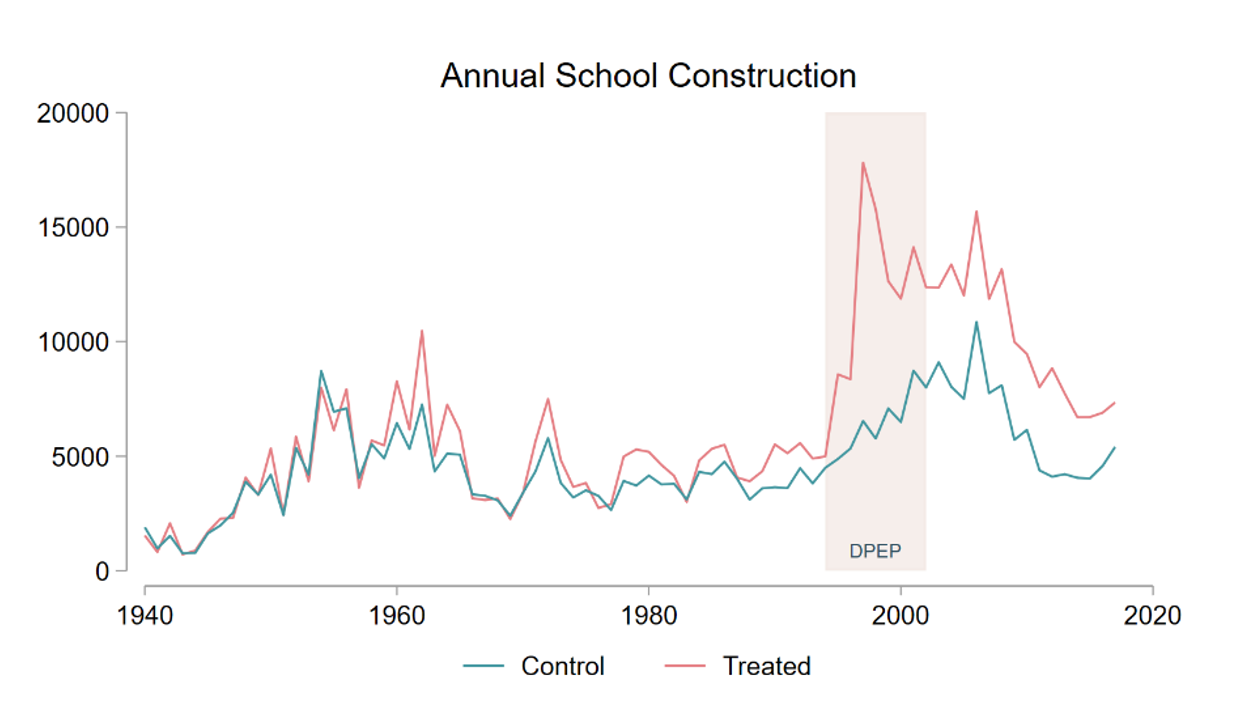The accumulation of skills can be a driver of adaptation to climate change. Human capital facilitates occupational change and increases migration opportunities. Tim Dobermann studied how historical investments in education facilitated adaptation in India. He finds that areas that benefited from expansion in schooling saw labour leave agriculture in response to climate change.
Can the world’s poor adapt to climate change in time? Two facts make this a pertinent question. The first is that the grip of climate change is tightening around the world. Greater heat extremes and stronger storms, floods and droughts are destroying lives and livelihoods. The second fact is that those who are most exposed to these changes inhabit the geographic belt around the equator, precisely where the majority of the world’s poor live.
Answering whether the poor can adapt requires understanding their economic lives. The majority of the world’s poor derive their income directly or indirectly from agriculture. They either cultivate small plots of land or work as informal agricultural wage labourers. Climate change erodes the inherent productivity of their main source of livelihood. The impact on crop yields is estimated to be substantial.
With adequate resources and knowledge, farmers could invest into technologies that mitigate these impacts. However, smallholder farmers in developing countries often do not possess such resources. An alternative adaptation strategy is to be mobile across sectors or space, leaving behind the occupations or locations that are most vulnerable. Once more, the same constraints that keep the poor stuck in low-wage agriculture, such as a lack of capital, now also prevent them from reducing their exposure to climate change.
My research argues that the accumulation of human capital can be a key driver of adaptation. By building up the human capital of the world’s poor, we can lessen the impacts of the climate crisis. Human capital facilitates occupational change as well as increases opportunities to migrate. Occupations that are less exposed to climate change ultimately take place in markets for human capital, meaning those with more skills have better opportunities to reallocate out of agriculture sooner. Globally, the growth of human capital across age cohorts has driven a substantial share of the observed shift of workers out of agriculture and into manufacturing and services. Despite the enormous expansion in access to education, the speed of human capital accumulation may still be lower than desired as the poor face constraints, are far from labour markets where they can supply their skills and are unaware of future changes in climate. Investing in oneself is an investment into resilience; an asset which cannot be eroded by the weather.
I study how historical investments into education facilitated adaptation to climate change in India. Climate change, as measured by changes in growing and killing degree days for five major crops, has already taken place in recent decades. Growing degree days (GDD) capture the amount of time over the growing season that temperatures fall within optimal bands for crop growth. Killing degree days (KDD) measure how long crops are exposed to very high temperatures which are deleterious for plant development. It is these killing days that cause the most damage to crop yields. Wheat and rice, of the major crops of India, have seen sustained rises in KDD over the past six decades (Figure 1). Furthermore, this decline is throughout the country: most areas have witnessed a decline in overall growing potential (Figure 2).
Figure 1. Growth in killing degree days (KDD) across India for wheat and rice

Figure 2. Change in annual killing degree days (KDD) between the long run average up to 1970 and 2016

These changes can have an ambiguous effect on the occupations chosen by the poor. Substitution effects pull labour out of fields as the value of working in agriculture declines, while income effects keep labour in them as agricultural goods remain a key commodity. In line with other literature on climate change and labour reallocation, I find that areas with increased extreme temperatures during the growing season see more labour in agriculture.
The primary question, however, remains whether areas with more human capital were able to adapt to this increase in killing degree days. I exploit an eligibility cutoff for a large-scale schooling expansion in India in the mid-to-late 1990s to test whether areas that received more schools in the past saw greater reallocations out of agriculture in response to climate change. India’s District Primary Education Programme (DPEP) saw a dramatic increase in the number of schools across the country by building over 160,000 schools (Figure 3).
Figure 3. School constructions between districts in India that were under the DPEP (treated) and those which were not (control)

I compare how the share of people working in agriculture changes in response to climate change between areas that saw this injection of human capital to those which did not. I find that areas which benefited from the schooling expansion saw labour leave agriculture in response to climate change. In contrast, areas which did not benefit were not able to adapt to climate change by shifting labour away from agriculture. I interpret this as evidence for human capital’s role in allowing individuals to readily adapt. Similarly, there is evidence suggesting that human capital in these areas helped increase migration following the change in climate. Overall consumption levels appear unaffected.
While illustrative, this evidence does not answer how the poor will fare in the future as climate change worsens. If more people are being affected by climate change, then more people will be looking for alternatives that are safe. This generates competition in markets for human capital, like the services sector. Understanding how climate change affects me tomorrow, therefore, requires knowing how it will affect others and how they may try to adapt. I use a rich spatial model of structural change and migration to explore these dynamics. Human capital is costly to acquire but rewards you with higher wages in sectors that demand more skills. Rural locations specialising in agriculture have lower labour market access and less production outside of agriculture. These dynamics drag down the optimal rate of investment into education. Unanticipated climate change further lowers this as agricultural incomes decline. Over time, human capital clusters in urban centres are diversified out of agriculture. This inequality reinforces the disparity in access to markets for human capital. Governments could subsidise education to raise human capital sooner and thus ensure a more even spread of skills (human capital), creating more opportunities for local adaptation to take place.
Adapting to climate change will require a fundamental shift in how and where we engage in work. The human capital each individual carries with them could be a crucial tool to assist them in this process of adaptation.
- This blog post is based on “Human Capital and Structural Transformation in the Race Against Climate Change”, presented during LSE 2023 Environment Week.
- The post represents the views of its authors, not the position of LSE Business Review or the London School of Economics.
- Featured image by PradeepGaurs / Shutterstock.com
- When you leave a comment, you’re agreeing to our Comment Policy.






